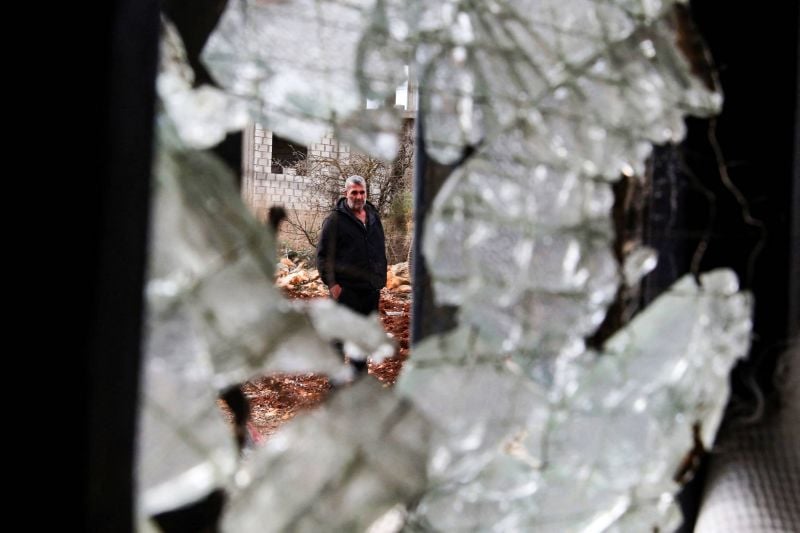
Lebanese farmer and minibus driver Abdallah Abdallah inspects his damaged home in Aitaroun, southern Lebanon near the Israeli border, on Nov. 25, 2023. Abdallah Abdallah went back to his village near the Israeli border on Saturday to find that weeks of bombing had badly damaged his house and destroyed his tractor. (Credit: Mahmoud Zayyat/AFP)
Want to get the Morning Brief by email? Click here to sign up.
Catch up on our LIVE coverage of Day 49, Day 50 and Day 51 of the Israel-Hamas war.
The Hamas-Israel truce provided a precarious calm to displaced southern Lebanon residents, allowing them to briefly visit their homes after nearly seven weeks of cross-border conflicts between Hezbollah and Israel. The pause in fighting prevailed, though perforated by the sound of Israeli drones and an Israeli interceptor missile detonated over southern Lebanon along with mortar shelling on the outskirts of Marwahin (Sour district) and Israeli gunfire hit UN peacekeepers without causing casualties as well as an olive farmer's utility vehicle as he was working in his field in al-Wazani. The Lebanese Army warned returning residents to beware of phosphorus munitions and unexploded shells. Many residents returned to find their homes and belongings damaged by Israeli shelling. One resident told L’Orient Today that misfired Hezbollah rockets damaged his home in Ain Ibl. The village’s mayor said that approximately 70 percent of its 4,000 residents had fled, noting that many of those who remained could not afford to do otherwise. “Other families have lost their income. This is olive harvest season and we lost two-thirds of what was supposed to be collected,” the mayor continued. Attitudes varied among the people interviewed by L’Orient Today: Some remained throughout the conflict, while others, after finding their homes damaged, said they were only briefly returning. “Where is the state?” one couple asked, decrying the absence of official support while they sheltered in a nearby school. The Lebanese Health Ministry, in its first official report earlier this month, estimated that 26,232 people have been displaced since Oct. 7, adopting the figure given by the International Organization for Migration (IOM). A small group of people paid their respects to slain al-Mayadeen journalists Farah Omar and Rabih Maamari in Tayr Harfa, Sour where they were killed by an Israeli strike while reporting from the area.
Caretaker Education Minister Abbas Halabi is scheduled to tour southern Lebanon today as part of a plan to launch emergency response schools to enroll students displaced by the conflict, the state-run National News Agency (NNA) reported. According to the NNA’s agenda, Halabi will be accompanied by representatives of international organizations and donors during his tour of the Abbassiya public school in Sour and the Ghazieh public school in Saida. Schools near Lebanon’s southern border have been shut since the start of cross-border clashes on Oct. 8.
French Special Envoy for Lebanon Jean-Yves Le Drian is expected to return to Beirut on Wednesday for a fourth visit attempting to mediate a resolution of the presidential impasse, An-Nahar and Asharq al-Awsat reported yesterday. Le Drian last Wednesday told French radio France Info he would visit Lebanon “very soon.” France’s envoy said his visit comes at French President Emmanuel Macron’s request to convey to Lebanese officials that their “sense of responsibility” must return as they face a dual executive vacuum, along with its interruptions to Parliament and cabinet’s functioning while “war is at the gates.”
Israel and Hamas traded prisoners after seven weeks of shelling on Gaza that killed at least 14,854 people including more than 6,000 children, installing a temporary truce which Israeli military officials said will be followed by “immense pressure” for the release of additional hostages. Despite the truce, Israeli forces have reportedly shot and killed several people in Gaza — notably people attempting to return to northern Gaza. Hamas said they are seeking to prolong the truce by releasing more hostages. Israeli Prime Minister Benjamin Netanyahu, during his first visit to Gaza since Oct. 7, added that Israel’s army would not stop until it “eliminates Hamas” and “ensures that Gaza does not become a threat to Israel again.” Hamas released 24 hostages on Friday, 13 others on Saturday and an additional 17 people yesterday, most of whom were Israeli women and children as well as US, Thai, Filipino, German and Russian nationals. Hamas is estimated to have taken around 240 people hostage on Oct. 7 — some of whom the group said were killed by Israel’s relentless shelling since then. Hamas previously released other hostages for medical reasons. Israel successively released 117 women and children detained in its prisons over the past three days. As part of the Qatar-Egypt-US-mediated exchange, the International Committee of the Red Cross (ICRC) has ferried Hamas-held hostages, sometimes via Egypt, for their handover to Israeli authorities. The pause in fighting included an increase in aid delivered to Gaza, including fuel and cooking gas. A Hamas spokesperson cited by Reuters said less aid than previously agreed on with Israel was allowed to enter northern Gaza. Only four of northern Gaza’s hospitals remain operational according to the UN Office for the Coordination of Human Affairs (OCHA), while the enclave’s overall bed capacity is less than half of what it was before Oct. 7. Thousands emerged from shelters across Gaza after the war triggered mass displacement, AFP reported.
In case you missed it, here’s our must-read story from over the weekend: “Southern Lebanese villagers return to damaged homes for first time, amid current Israel-Hamas truce”
Compiled by Abbas Mahfouz